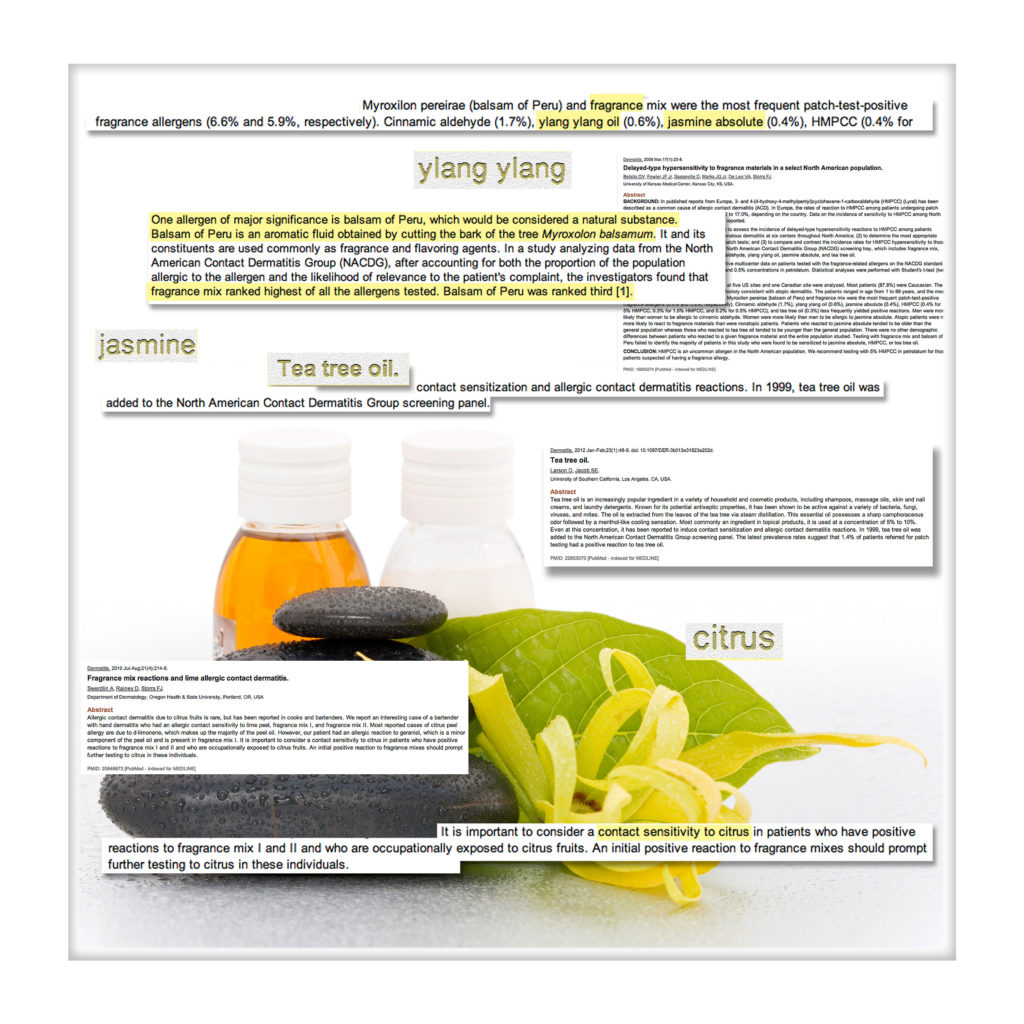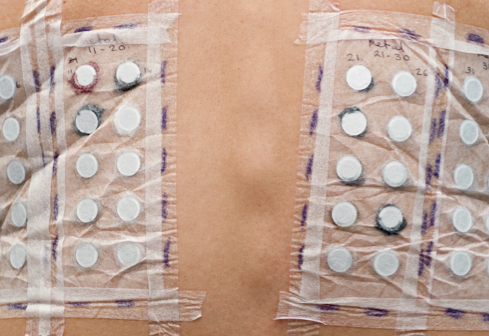Yes and no. Yes because natural (or really, organic, which is a regulated term) means less processing. Less processing means less contaminants (like specific chemicals used in growing, storage, or extraction), additives (like flavors, colors, fragrance, or preservatives), or alterations (like bleaching or heating). Because many contaminants, additives, and alterations are common allergens, organic can mean less risk of an allergic reaction. No, natural ingredients are not necessarily good for sensitive skin because many natural extracts (although by no means all) are common allergens.
“But I was told to look for ‘hypoallergenic’ for my super sensitive skin…which means ‘natural,’ right?”
Natural does not mean hypoallergenic. In fact, the opposite is frequently true. Many natural ingredients are highly allergenic, such as fragrance oils, citrus, beeswax, fruit and flower extracts, tea tree oil, ylang, ylang, etc. The image above is a very small snapshot of many, many published studies on contact reactions and allergies to several natural ingredients.
Food and skin allergies should not be equated (because different cells are involved, you could be allergic to a food and still be able to use it as an ingredient in skincare, and vice versa — don’t experiment without your allergist’s guidance, however). But in both food and skin allergies, an ingredient’s level of “naturalness” isn’t necessarily what makes it allergenic. If you are allergic to strawberries, bee stings, dairy, mangoes, pollen, or dander, you should avoid them no matter how organic they are. In skincare and cosmetics, if your patch test shows that you are allergic to chrysanthemum, lavender, or citrus extracts, you should avoid them even if they are certified organic.
“But what if I’m committed to a completely natural, totally unprocessed lifestyle?”
This might be the goal, but it would be close to impossible to achieve. Almost anything in nature needs some type of processing to be used in skin care, so that they can be mixed and stabilized. Even if an ingredient is truly “raw,” it still probably underwent a little rudimentary processing. For example, virgin coconut oil needs to be pressed out from coconut meat. Strictly speaking, just the pressing is a type of processing. What you would need to know is what specific processing was done and how much of it was done. Our virgin coconut oil is certified organic from soil to tree, and is first-and-cold-pressed — meaning we basically just press the oil. Some other coconut oils are processed with heat which can alter some of the oil’s chemical makeup. Other coconut oils are processed with additives that can be allergens, which can leave traces in the oil and cause reactions (check out this helpful article in skintelligencenter.com for more on virgin coconut oils).
In other natural ingredients, processing can yield surprising results. For example, the distillation process to make essential oils — even organic, “raw” oils for massages or scents — can create chemicals that did not exist in the original plant. And even if they were somehow processed not to create these new chemicals, many natural oils are comedogens or allergens just as they are.
One other important consideration: whether or not an ingredient is natural has little to do with its efficacy. Studies that are “evidence-based” (double-blind, randomized trials with quantitative data) are the gold standard to prove efficacy, but they are relatively rare in cosmetics. Publication in a peer-reviewed medical journal or presentation in a medical conference is rarer still but adds even more scientific validity to the study. Unless a natural ingredient is proven to be effective, it may not yield the results you’re looking for. If the natural ingredient is also a photo-allergen (reacts with light to cause darkening) or is comedogenic, it could also be working against you by causing dark splotches or acne. Check out this article for how hypoallergenic can help all skin concerns.
As well, the term “natural” is not currently regulated so it is almost impossible to confirm how natural a product is, how natural its ingredients are, or how much processing was done to those ingredients. The term “organic” is regulated and requires certification. Organic is certainly the best choice for most things. But hypoallergenic (validated “hypoallergenic” — ask for proof) trumps organic every time when caring for sensitive skin.
“What if I just do not want to use anything with chemicals?”


This is an admirable goal and one that many people share. Invented chemicals like PVC are toxic and the earth doesn’t have ways to break them down. Highly processed foods are proven to be damaging on many levels, from obesity to toxins that accumulate in the body. But lessening processed foods and trying to use more biodegradable options is not the same as “avoiding chemicals altogether.”
The line between “natural” and chemical is difficult to draw. “Chemicals” can mean almost anything, including “natural” ingredients. Everything in nature has a chemical structure, is composed of chemical elements (see the periodic table) and has a chemical structure. The chemical structure for water is hydrogen and oxygen, and is shown above. Also shown above is the chemical structure of glyceryl laurate (monolaurin). Monolaurin is derived from coconut oil and is an excellent, very natural, non-allergenic, non-drying antimicrobial (so natural it’s found in breast milk).
“What if I’m allergic to chemicals?”
It’s more likely that you are allergic to common allergens. Allergens (substances more likely to cause an allergic reaction) are determined systematically in patch tests on thousands of people in different countries and are published regularly. The recent publications regularly include results on over 20,000 people in multiple countries in North America and Europe. We also regularly monitor published reports regarding allergic reactions from other countries such as Australia and Japan.
If you have a history of reactions, skin sensitivity, dark splotches, or acne, look for proven, validated hypoallergenic and non-comedogenic claims. Or, even better, ask your dermatologist for a patch test. It is the most effective way to accurate identify what exactly you might be sensitive to. If you’re in the USA and your dermatologist is a member of the American Contact Dermatitis Society, she can even enter your patch test results into the Contact Allergen Management System (CAMP) and give you a list not only of ingredients to avoid but actual products you can use.
Shop:
To shop our selection of hypoallergenic products, visit vmvhypoallergenics.com. Need help? Ask us in the comments section below, contact us by email, or drop us a private message on Facebook.
Learn More:
To read more about natural versus hypoallergenic, check out Is Natural Hypoallergenic? The Answer May Surprise You (But Shouldn’t).
For more on the prevalence of skin allergies, see Skin Allergies Are More Common Than Ever and One In Four Is Allergic to Common Skin Care And Cosmetic Ingredients.
To learn more about the VH-Rating System and hypoallergenicity, click here.







